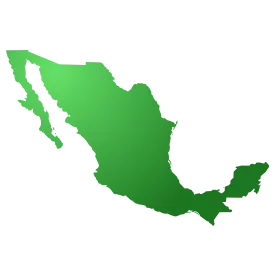Mexico
Discover Mexico
Fun Foods
Tacos, Enchiladas, Buñuelos, Churros
Mexico, a country in North America, is the 13th largest country in the world by area. It’s made up of 31 states and its capital, Mexico City, sits over 7,000 feet above sea level. The land stretches from deserts in the north to rainforests in the south.
Indigenous peoples shaped this land first. The Olmec left giant stone heads near Veracruz. They set the stage for later cultures.
The Maya thrived in the Yucatán and parts of Guatemala. They built steep pyramids, mapped stars and wrote in glyphs. Their cities like Palenque still stand today.
In central Mexico the Aztecs created a powerful empire. They built Tenochtitlan on a lake with causeways and canals. They farmed chinampas that floated on Lake Texcoco to feed the population.
In 1519 Hernán Cortés arrived with horses and steel weapons. He made alliances with tribes who hated Aztec rule. By 1521 Cortés and his allies conquered Tenochtitlan and began three centuries of Spanish rule.
Under the Viceroyalty life revolved around silver mines in Zacatecas and Guanajuato, and silver wealth built churches and supported global trade through Manila galleons. Mission churches rose in every region. A rigid social order placed Spaniards at the top and indigenous people at the bottom.
In 1810 Padre Miguel Hidalgo rang the bell at Dolores and called for independence. Rebels fought battles at Guanajuato and Monte de las Cruces. After years of war Mexico won freedom in 1821 under Agustín de Iturbide.
The young republic faced instability, frequent power changes and regional revolts. From 1846 to 1848 Mexico lost half its land to the United States in the Mexican-American War. Leaders like Antonio López de Santa Anna rose and fell amid coups.
In the 1850s liberals under Benito Juárez passed the Reform Laws. They took power from the church and military. Juárez also resisted a French invasion in the 1860s.
On May 5, 1862 Mexican forces beat the French at Puebla. This victory united citizens against an empire headed by Maximilian. Today people celebrate Cinco de Mayo with music, parades and traditional foods.
In 1910 peasants, workers and middle-class leaders rose in rebellion. Figures like Emiliano Zapata and Pancho Villa seized land for farmers. The Revolution ended in 1920 and gave birth to the 1917 Constitution.
In the 20th century the Institutional Revolutionary Party, or PRI, held power for decades under a system that balanced unions, landowners and the military. It built roads, schools and an oil industry. Critics say it also stifled opposition and ignored poverty.
In 1994 Mexico joined NAFTA to boost trade with the U.S. and Canada, and factories known as maquiladoras grew along the northern border. That sparked growth but also exposed low wages and new social pressures. Economic crises, migration and calls for reform followed uneven development.
Mexico celebrates life with colorful traditions and regional customs. Day of the Dead honors ancestors with altars of marigolds, sugar skulls and pan de muerto. Carnival parades swirl in Veracruz each spring, and Independence Day lights up plazas with fireworks on September 16.
Artists like Diego Rivera and Frida Kahlo painted murals and canvases that tell Mexico’s story in colors and symbols. Their work inspires Mexicans and visitors alike.
Come see the pyramids at Teotihuacan and Chichén Itzá, swim in the cenotes of the Yucatán and relax on the beaches of Cancún or Puerto Vallarta. Taste tacos al pastor, mole poblano and fresh tamales.


Experience Points


XP EARNED OUT OF 0
Points Breakdown
| Sticker Collected | 0 XP |
| Card Collected | 0 XP |
| Bonuses | 0 XP |
| Total | 0 XP |
Your travel history

First Visit
---
Last Visit
---
You've logged 0 visits.
Sticker Collection
.webp)
Campeche
Served as a defense against pirates in the 1600's.
.webp)
Guanajuato
One of the world's leading silver producers in the 18th century.

Mexico City
Sitting at over 2200 meters above sea level, it's the oldest capital city in the Americas.

Morelia
Known for it's elegant and distinct Spanish colonial architecture.


